Search Result
Results for "
cardiac arrhythmia
" in MedChemExpress (MCE) Product Catalog:
1
Biochemical Assay Reagents
8
Isotope-Labeled Compounds
| Cat. No. |
Product Name |
Target |
Research Areas |
Chemical Structure |
-
- HY-119802
-
-
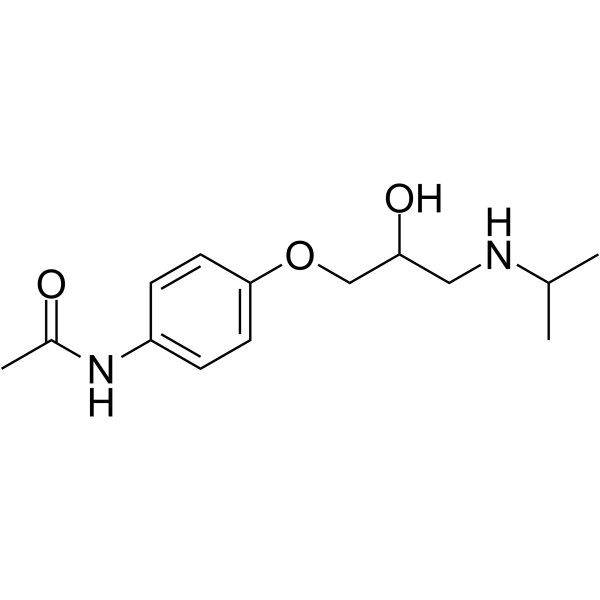
-
- HY-103059
-
|
|
Calcium Channel
|
Cardiovascular Disease
|
|
SOICR-IN-1 (compound 32) is a store-overload induced calcium release (SOICR) inhibitor with an IC50 value of 14.6 μM. SOICR-IN-1 can be used for the research of cardiac arrhythmias .
|
-
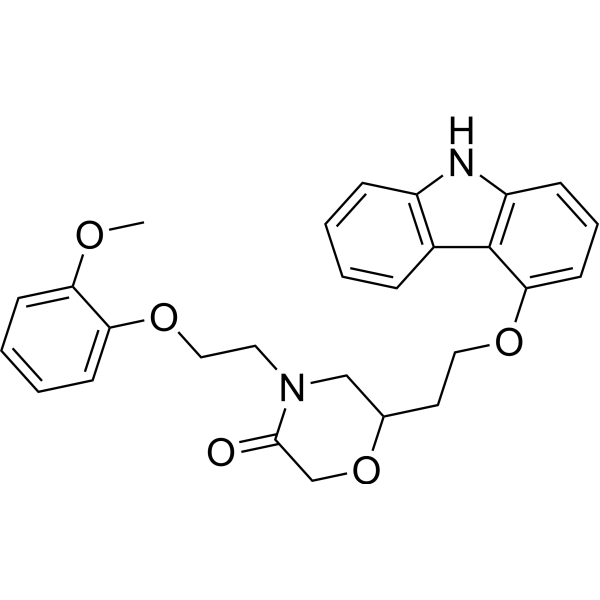
-
- HY-107754
-
|
|
Potassium Channel
|
Cardiovascular Disease
|
|
Cesium chloride is a blocker of potassium channel. Cesium chloride prevents the decrease of Na + transport produced by Alloxan . Cesium chloride has induced cardiac arrhythmias, including torsade de pointes in animal models .
|
-
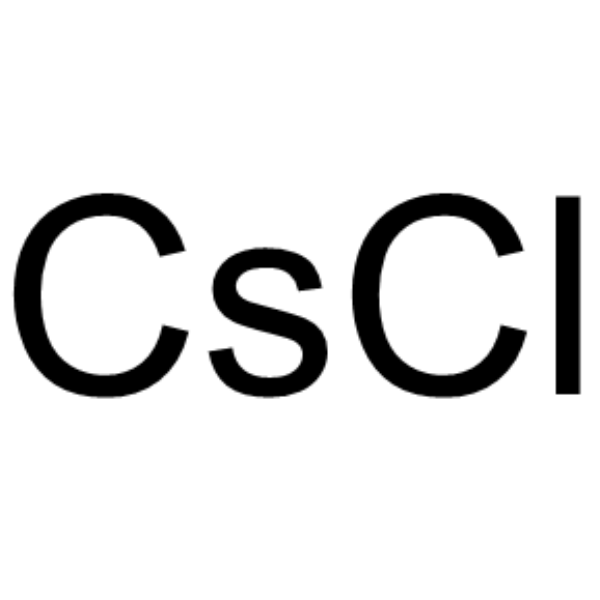
-
- HY-B0632
-
|
|
Calcium Channel
|
Cardiovascular Disease
Cancer
|
|
Diltiazem is an orally active L-type Ca 2+ channel blocker. Diltiazem shows antihypertensive and antiarrhythmic effects. Diltiazem can be used for the research of cardiac arrhythmia, hypertension, and angina pectoris .
|
-
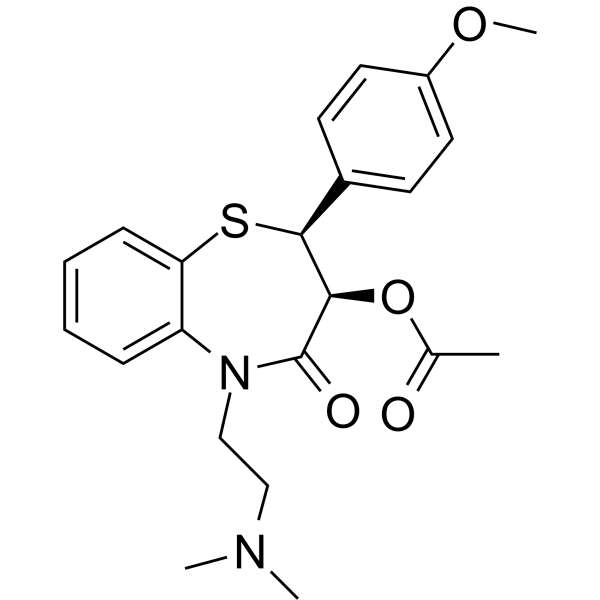
-
- HY-17497
-
-
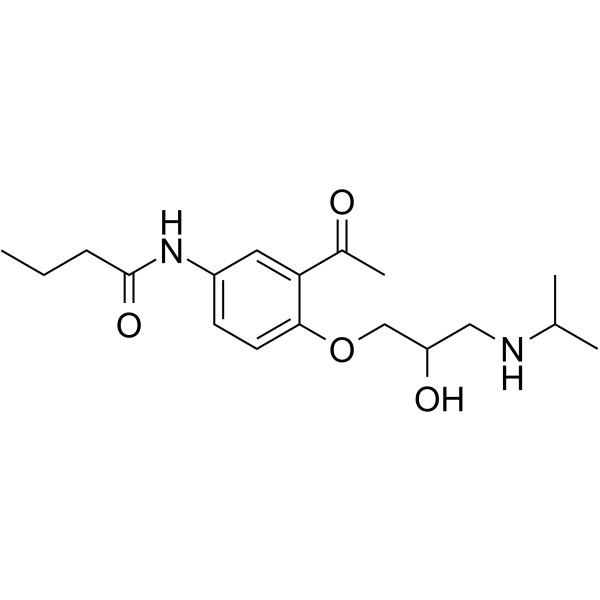
-
- HY-B0632A
-
|
MK 793
|
Calcium Channel
|
Cardiovascular Disease
|
|
Diltiazem malate is a potent and orally active L-type calcium channel inhibitor. Diltiazem malate shows antihypertensive and antiarrhythmic effects. Diltiazem malate can be used for the research of cardiac arrhythmia, hypertension, and angina pectoris .
|
-

-
- HY-16738A
-
|
GS 6615 hydrochloride
|
Sodium Channel
Potassium Channel
|
Cardiovascular Disease
|
|
Eleclazine (GS 6615) hydrochloride is a selective cardiac late sodium current inhibitor and a weak inhibitor of potassium current with IC50 value of <1 μM and approximately 14.2 μM, respectively. Eleclazine hydrochloride shows concurrent protection against autonomically induced atrial premature beats, repolarization alternans and heterogeneity, and atrial fibrillation in porcine model. Eleclazine hydrochloride can be used to research cardiac arrhythmias .
|
-

-
- HY-114846
-
|
|
Prostaglandin Receptor
|
Cardiovascular Disease
|
|
Ro 22-9194 inhibits aggregation and thromboxane Az (TXA2) synthetase activity in rabbit and human platelets. Ro 22-9194 has a potent inhibitory action against various types of model arrhythmias. Ro 22-9194 has non-cholinergic cardiac depressant properties with its vasodilating action .
|
-
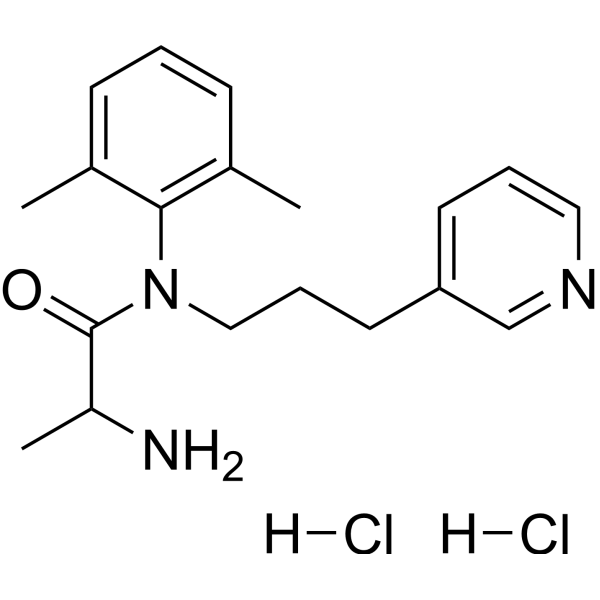
-
- HY-106225
-
|
ZP123
|
Gap Junction Protein
|
Cardiovascular Disease
|
|
Rotigaptide (ZP123) is a novel and specific modulator of connexin 43 (Cx43). Rotigaptide prevents the uncoupling of Cx43-mediated gap junction communication and normalizes cell-to-cell communication during acute metabolic stress. Rotigaptide is a potent antiarrhythmic peptide (AAP) with improved stability and has the potential for the investigation of cardiac arrhythmias-specifically atrial fibrillation .
|
-
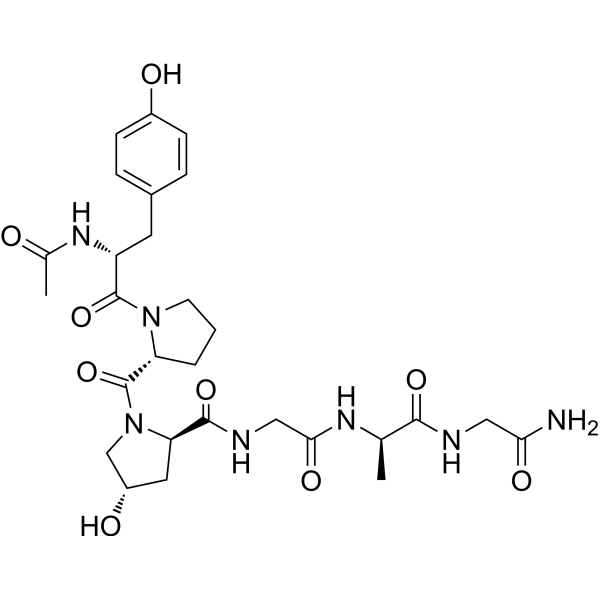
-
- HY-149779
-
|
|
Calcium Channel
|
Cardiovascular Disease
|
|
RyR2 stabilizer-1 (compound 12a) is a potent RyR2 stabilizer and SERCA2a activator with EC50s of 2.7 μM for RyR2 and 383 nM for SERCA2. RyR2 stabilizer-1 inhibits Ca 2+ leakage from the SR RyR2 while promoting SERCA2 to pump Ca 2+ back to SR, which make RyR2 stabilizer-1 possible to prevent cardiac arrhythmias .
|
-

-
- HY-17497S
-
-

-
- HY-A0084S
-
|
Procaine amide-d4 hydrochloride; SP 100-d4 hydrochloride
|
Isotope-Labeled Compounds
|
Cancer
|
|
Procainamide-d4 hydrochloride is deuterated labeled Procainamide. Procainamide hydrochloride is an antiarrhythmic agent used in the study of cardiac arrhythmias.
|
-
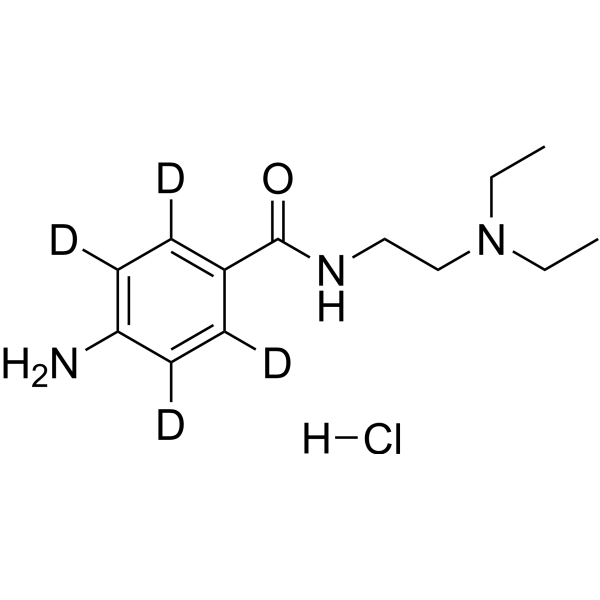
-
- HY-A0084S1
-
|
Procaine amide-13C2 hydrochloride; SP 100-13C2 hydrochloride
|
Isotope-Labeled Compounds
|
Cancer
|
|
Procainamide- 13C2 hydrochloride is 13C labeled Procainamide. Procainamide hydrochloride is an antiarrhythmic agent used in the study of cardiac arrhythmias.
|
-
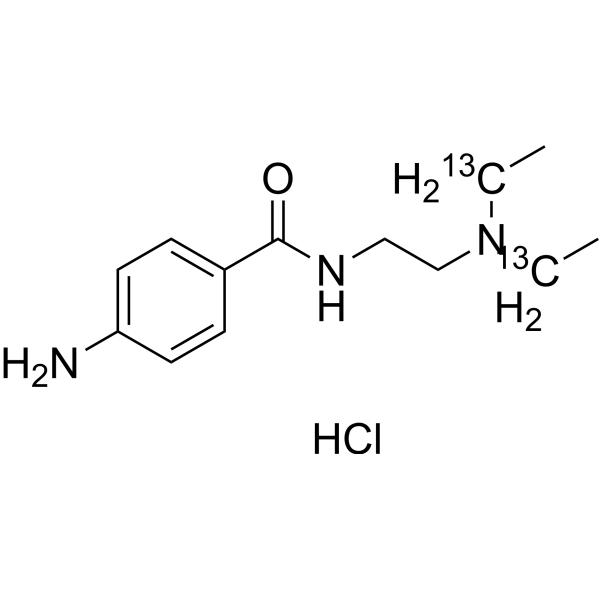
-
- HY-119802S
-
-
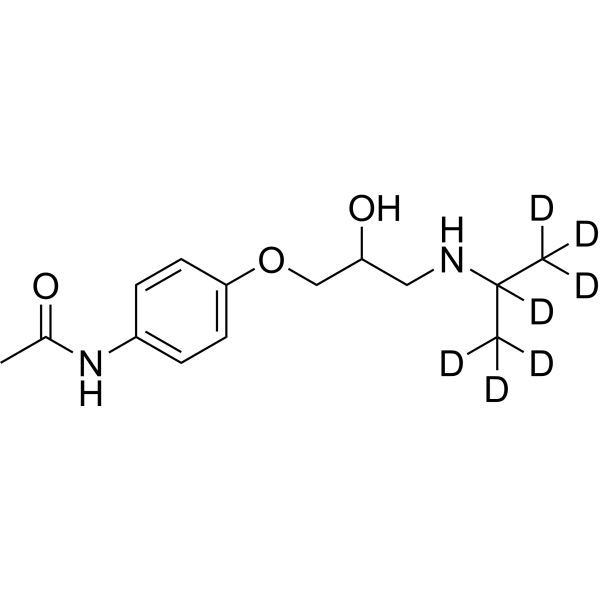
-
- HY-17417
-
|
|
Opioid Receptor
|
Neurological Disease
|
|
Naloxone hydrochloride is an antagonist of Opioid receptor. Naloxone hydrochloride alleviates opioid-overdose-induced respiratory depression. Naloxone hydrochloride may cause pulmonary edema and cardiac arrhythmias .
|
-
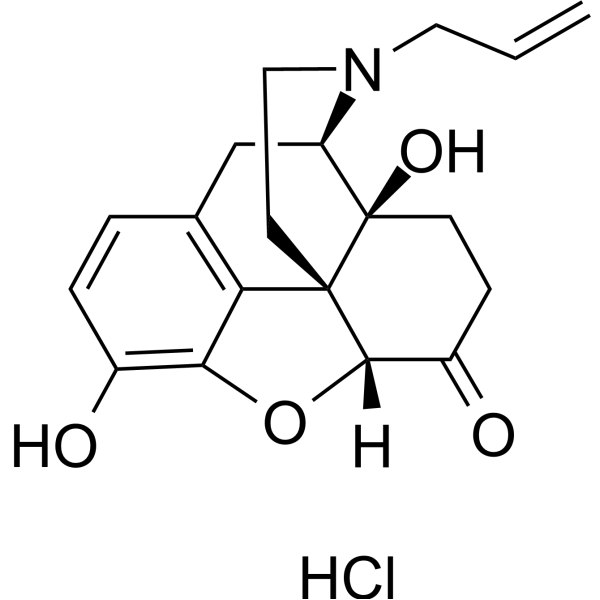
-
- HY-17417A
-
|
|
Opioid Receptor
|
Neurological Disease
|
|
Naloxone is an antagonist of Opioid receptor. Naloxone alleviates opioid-overdose-induced respiratory depression. Naloxone may cause pulmonary edema and cardiac arrhythmias .
|
-
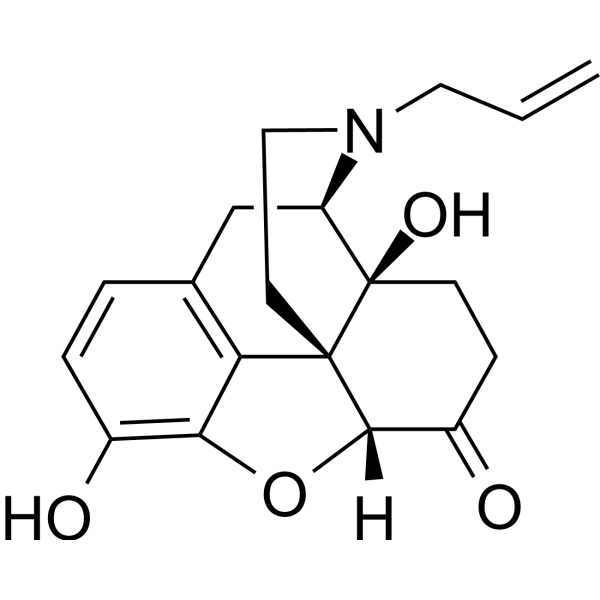
-
- HY-A0084
-
|
Procaine amide hydrochloride; SP 100 hydrochloride
|
Autophagy
|
Cancer
|
|
Procainamide hydrochloride is an anti-arrhythmic agent and is used to treat cardiac arrhythmia; induces rapid block of the batrachotoxin(BTX)-activated sodium channels of the heart muscle and acts as antagonist to long gating closures.
|
-
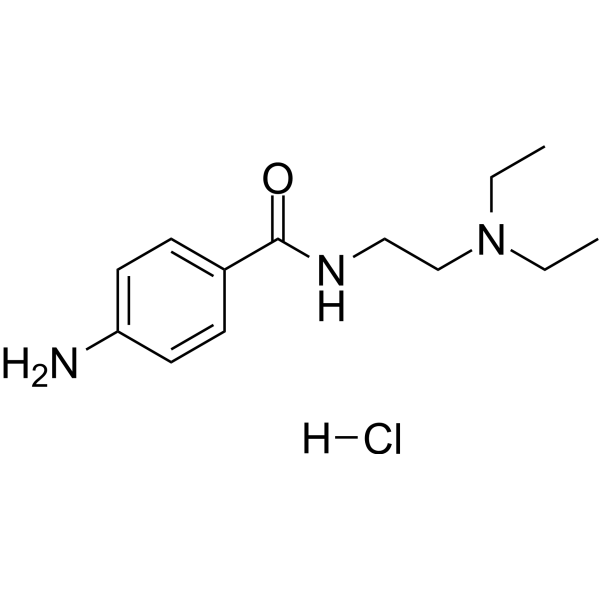
-
- HY-17497A
-
-

-
- HY-12533
-
|
Dicorantil; SC-7031
|
Sodium Channel
Potassium Channel
|
Cardiovascular Disease
|
|
Disopyramide (Dicorantil) is a class IA antiarrhythmic agent with efficacy in ventricular and atrial arrhythmias. Disopyramide blocks the fast inward sodium current of cardiac muscle and prolongs the duration of cardiac action potentials. Disopyramide inhibits HERG encoded potassium channels. Disopyramide also exhibits complex protein binding, and has a potent negative inotropic action .
|
-
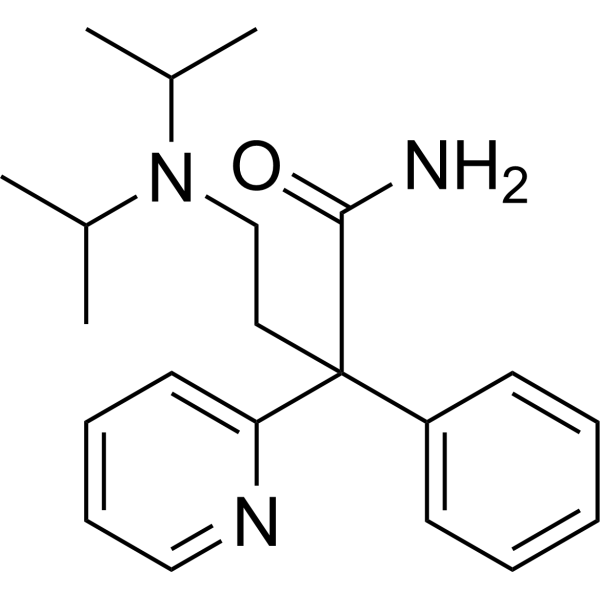
-
- HY-12533A
-
|
Dicorantil phosphate; SC-7031 phosphate
|
|
|
|
Disopyramide phosphate is a class IA antiarrhythmic agent with efficacy in ventricular and atrial arrhythmias. Disopyramide phosphate blocks the fast inward sodium current of cardiac muscle and prolongs the duration of cardiac action potentials. Disopyramide phosphate inhibits HERG encoded potassium channels. Disopyramide phosphate also exhibits complex protein binding, and has a potent negative inotropic action .
|
-

-
- HY-17429
-
|
R-818
|
Sodium Channel
|
Cardiovascular Disease
|
|
Flecainide acetate (R-818) is a class 1C antiarrhythmic agent especially used for the management of supraventricular arrhythmia; works by blocking the Nav1.5 sodium channel in the heart, causing prolongation of the cardiac action potential.
|
-
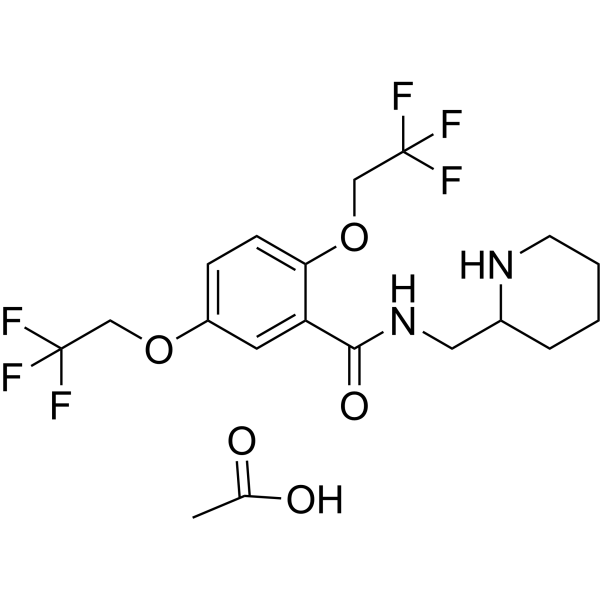
-
- HY-B2151
-
|
Cerberigenin; Echujetin
|
|
|
|
Digitoxigenin is a steroid derivative commonly found in various plants, especially the foxglove plant (Digitalis purpurea). Digitoxigenin has unique chemical properties that make it an important precursor for the synthesis of cardiac glycosides, a group of drugs used to improve heart failure and certain types of arrhythmias. It works by inhibiting the sodium potassium ATPase pump, thereby increasing the force and efficiency of cardiac contractions.
|
-

-
- HY-A0295
-
-
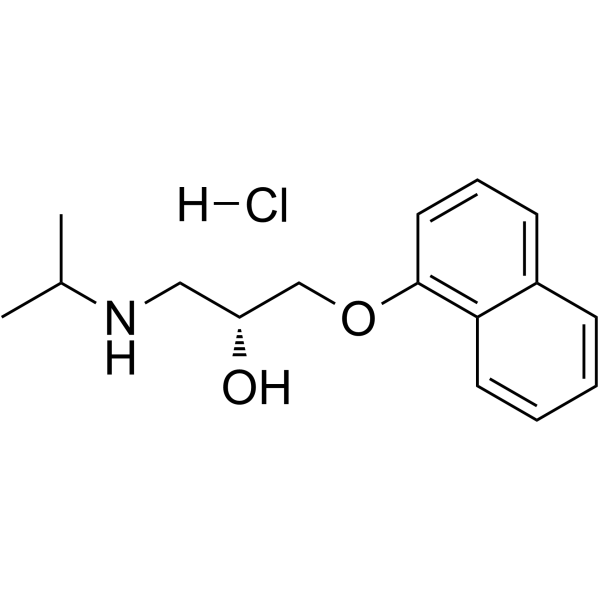
-
- HY-B1030
-
|
|
Flavivirus
Dengue virus
Autophagy
Enterovirus
|
Cardiovascular Disease
Cancer
|
|
Lanatoside C is a cardiac glycoside, can be used in the treatment of congestive heart failure and cardiac arrhythmia.Lanatoside C has an IC50 of 0.19 μM for dengue virus infection in HuH-7 cells. Lanatoside C can effectively inhibit all four serotypes of dengue virus, flavivirus Kunjin, alphavirus Chikungunya, Sindbis virus and the human enterovirus 71 .
|
-
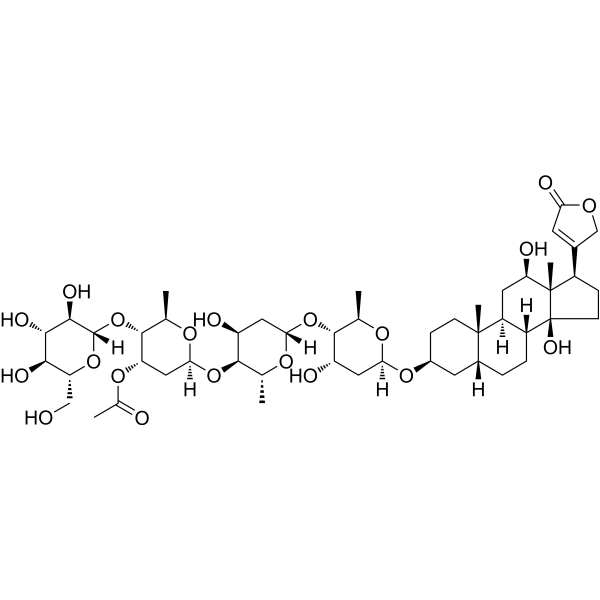
-
- HY-B0632S
-
|
|
Isotope-Labeled Compounds
Calcium Channel
|
Cardiovascular Disease
|
|
Diltiazem-d6 is the deuterium labeled Diltiazem. Diltiazem is an orally active L-type Ca2+ channel blocker, with antihypertensive and antiarrhythmic effects. Diltiazem can be used for the research of cardiac arrhythmia, hypertension, and angina pectoris[1][2][3].
|
-
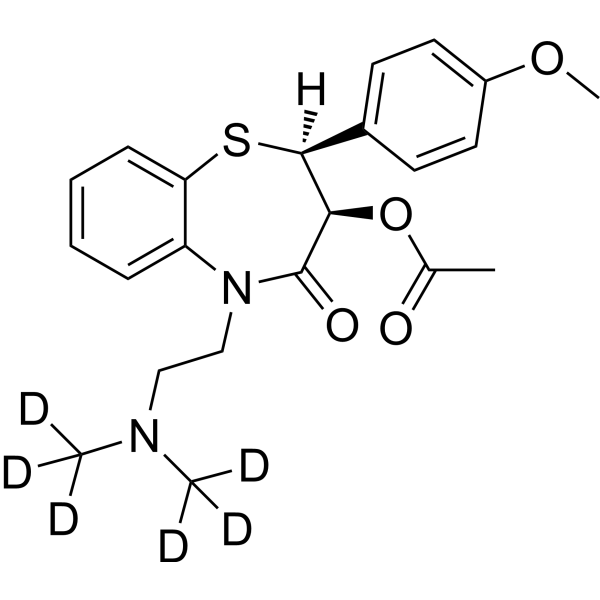
-
- HY-118406
-
|
Ponalid; UK 738
|
mAChR
|
Neurological Disease
|
|
Ethybenztropine (Ponalid) is a muscarinic receptor blocker. Ethybenztropine is an anticholinergic and antihistaminergic agent .
|
-
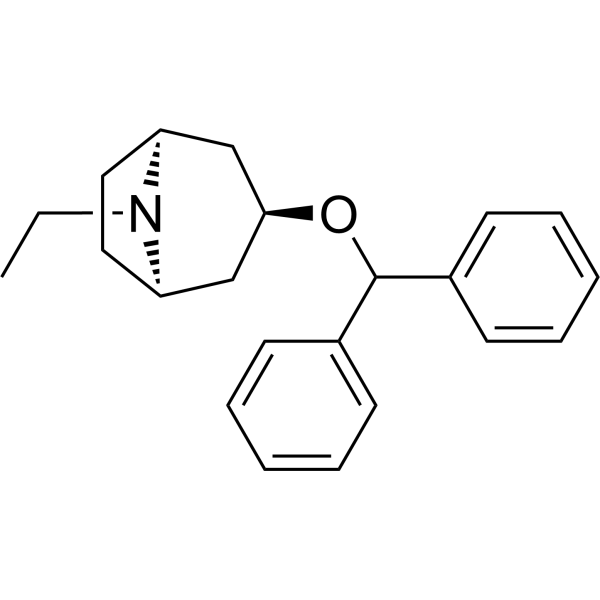
-
- HY-17429S
-
|
R-818-d4
|
Sodium Channel
|
Cardiovascular Disease
|
|
Flecainide-d4 (acetate) is the deuterium labeled Flecainide acetate. Flecainide acetate (R-818) is a class 1C antiarrhythmic agent especially used for the management of supraventricular arrhythmia; works by blocking the Nav1.5 sodium channel in the heart, causing prolongation of the cardiac action potential[1][2].
|
-

-
- HY-A0154
-
|
Deacetyllanatoside C; Desacetyllanatoside C
|
|
|
|
Deslanoside (Desacetyllanatoside C) is a rapidly acting cardiac glycoside used to treat congestive heart failure and supraventricular arrhythmias due to reentry mechanisms, and to control ventricular rate in the treatment of chronic atrial fibrillation. Deslanoside inhibits the Na-K-ATPase membrane pump, resulting in an increase in intracellular sodium and calcium concentrations .
|
-
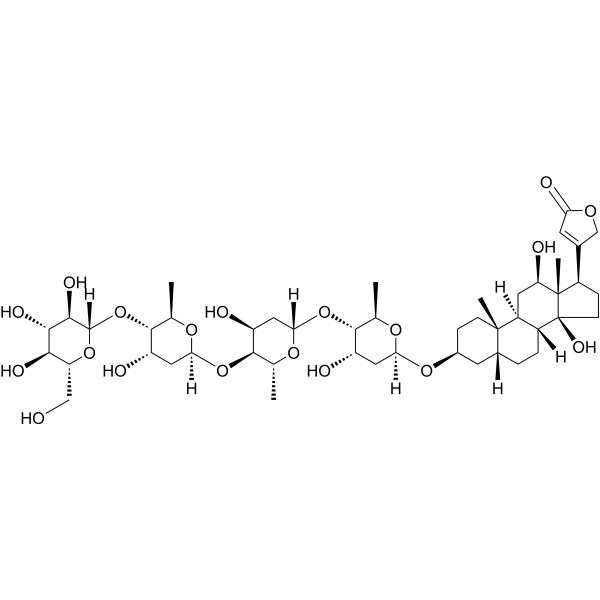
-
- HY-100952
-
|
|
|
|
|
Nifenalol hydrochloride is a β-adrenergic receptor antagonist. Nifenalol hydrochloride induces the Early Afterdepolarization (EAD) effect. EAD is a phenomenon in cardiac electrophysiology that usually occurs during an action potential in ventricular muscle cells and can lead to arrhythmia. The EAD effect of Nifenalol hydrochloride can be blocked by Tetrodotoxin. Nifenalol hydrochloride is used in the study of conditions such as irregular heartbeat or high blood pressure .
|
-
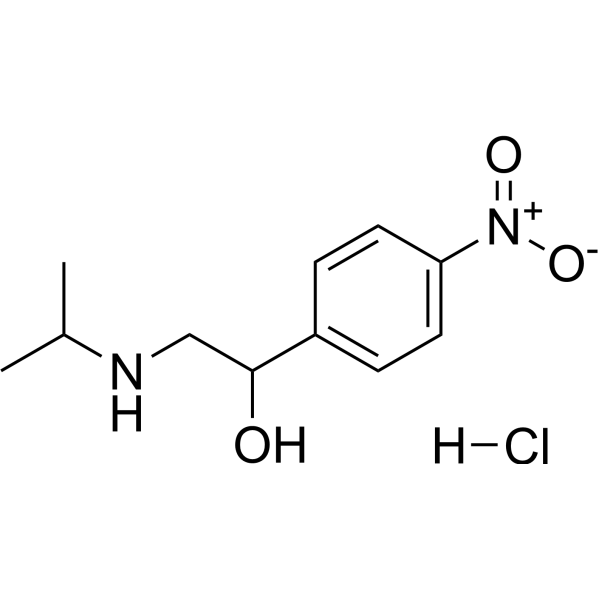
-
- HY-B0573A
-
|
|
|
|
|
(S)-(-)-Propranolol hydrochloride is a β-adrenergic receptor antagonist with log Kd values of -8.16, -9.08, and -6.93 for β1, β2, and β3, respectively. (S)-(-)-Propranolol hydrochloride the active enantiomer of propranolol and can be s used for study of hypertension, pheochromocytoma, myocardial infarction, cardiac arrhythmias, angina pectoris, and hypertrophic cardiomyopathy .
|
-
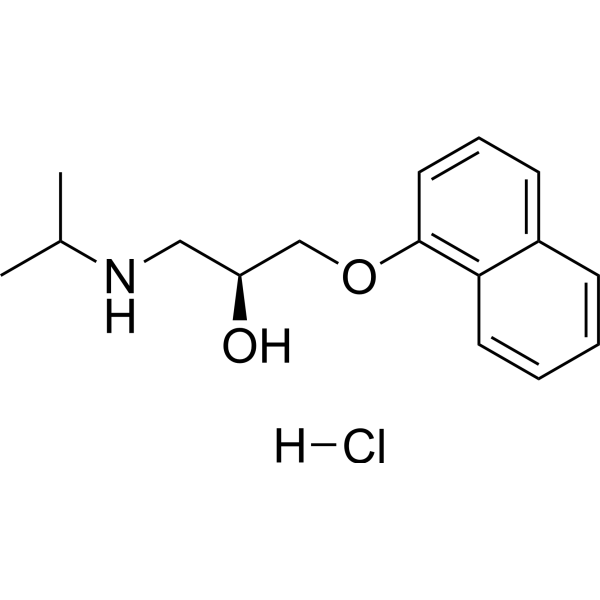
-
- HY-15292
-
S107
1 Publications Verification
|
Others
|
Cardiovascular Disease
|
|
S107 is an orally available, blood brain barrier-permeable compound, which stabilizes RyR2 channels by enhancing the binding of calstabin 2 to the mutant Ryr2-R2474S channel. S107 inhibits Ca 2+ leakage from the sarcoplasmic reticulum (SR) and prevents cardiac arrhythmias and raises the seizure threshold .
|
-
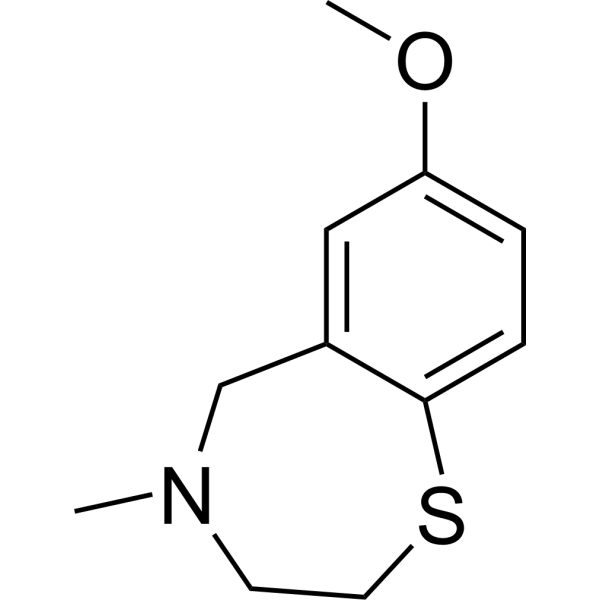
-
- HY-B0573
-
|
|
Adrenergic Receptor
Bacterial
|
Neurological Disease
Endocrinology
Cancer
|
|
Propranolol hydrochloride is a nonselective β-adrenergic receptor (βAR) antagonist, has high affinity for the β1AR and β2AR with Ki values of 1.8 nM and 0.8 nM, respectively . Propranolol hydrochloride inhibits [ 3H]-DHA binding to rat brain membrane preparation with an IC50 of 12 nM . Propranolol hydrochloride is used for study of hypertension, pheochromocytoma, myocardial infarction, cardiac arrhythmias, angina pectoris, and hypertrophic cardiomyopathy .
|
-

-
- HY-B0573B
-
Propranolol
Maximum Cited Publications
19 Publications Verification
|
Adrenergic Receptor
Bacterial
|
Cardiovascular Disease
Neurological Disease
Endocrinology
Cancer
|
|
Propranolol is a nonselective β-adrenergic receptor (βAR) antagonist, has high affinity for the β1AR and β2AR with Ki values of 1.8 nM and 0.8 nM, respectively . Propranolol inhibits [ 3H]-DHA binding to rat brain membrane preparation with an IC50 of 12 nM . Propranolol is used for the study of hypertension, pheochromocytoma, myocardial infarction, cardiac arrhythmias, angina pectoris, and hypertrophic cardiomyopathy .
|
-
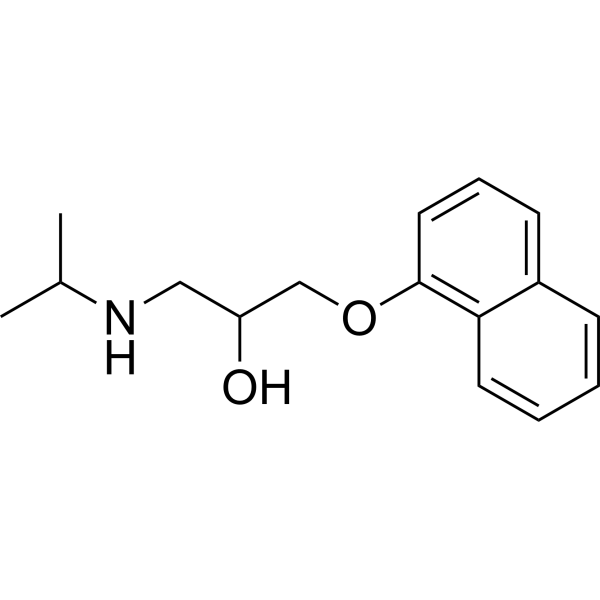
-
- HY-14186
-
|
WYE-160020
|
Potassium Channel
|
Cardiovascular Disease
|
|
KVI-020 is an orally active, potent and selective blocker of the atrial potassium channel Kv1.5, with an IC50 of 480 nM. KVI-020 can inhibits hERG, with an IC50 of 15100 nM. KVI-020 is a potent antiarrhythmic agent, and can be used for atrial fibrillation (AF) research .
|
-
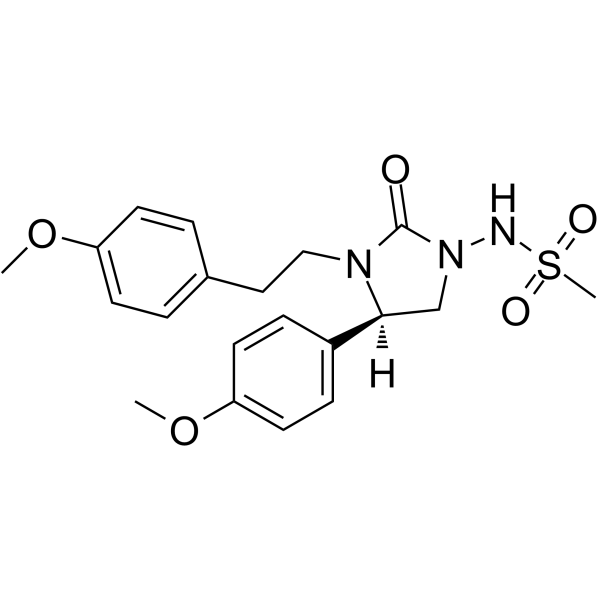
-
- HY-B0573BS
-
|
|
Adrenergic Receptor
|
Cardiovascular Disease
Neurological Disease
Endocrinology
|
|
Propranolol-d7 is the deuterium labeled Propranolol. Propranolol is a nonselective β-adrenergic receptor (βAR) antagonist, has high affinity for the β1AR and β2AR with Ki values of 1.8 nM and 0.8 nM, respectively[1]. Propranolol inhibits [3H]-DHA binding to rat brain membrane preparation with an IC50 of 12 nM[2]. Propranolol is used for the study of hypertension, pheochromocytoma, myocardial infarction, cardiac arrhythmias, angina pectoris, and hypertrophic cardiomyopathy[3].
|
-
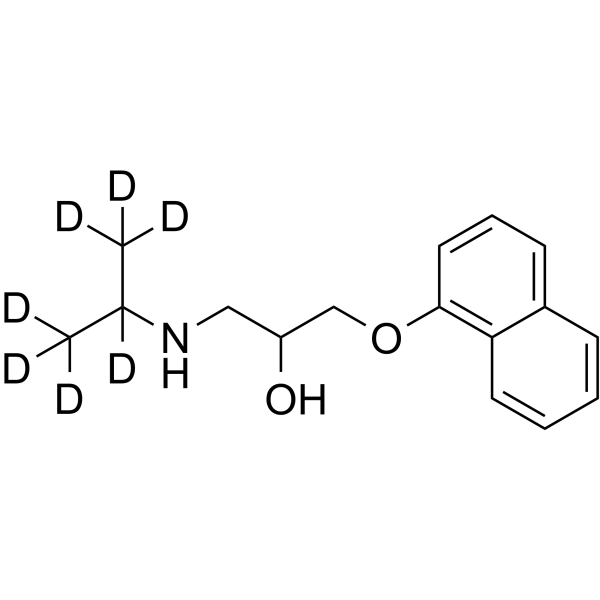
-
- HY-B0573S
-
|
|
|
|
|
Propranolol-d7 (hydrochloride) is a deuterium labeled Propranolol hydrochloride. Propranolol hydrochloride is a nonselective β-adrenergic receptor (βAR) antagonist, has high affinity for the β1AR and β2AR with Ki values of 1.8 nM and 0.8 nM, respectively[1]. Propranolol hydrochloride inhibits [3H]-DHA binding to rat brain membrane preparation with an IC50 of 12 nM[2]. Propranolol hydrochloride is used for the study of hypertension, pheochromocytoma, myocardial infarction, cardiac arrhythmias, angina pectoris, and hypertrophic cardiomyopathy[3].
|
-

-
- HY-B0573S1
-
|
|
Adrenergic Receptor
|
Neurological Disease
Endocrinology
|
|
Propranolol-d7 (ring-d7) is the deuterium labeled Propranolol hydrochloride. Propranolol hydrochloride is a nonselective β-adrenergic receptor (βAR) antagonist, has high affinity for the β1AR and β2AR with Ki values of 1.8 nM and 0.8 nM, respectively[1]. Propranolol hydrochloride inhibits [3H]-DHA binding to rat brain membrane preparation with an IC50 of 12 nM[2]. Propranolol hydrochloride is used for study of hypertension, pheochromocytoma, myocardial infarction, cardiac arrhythmias, angina pectoris, and hypertrophic cardiomyopathy[3].
|
-
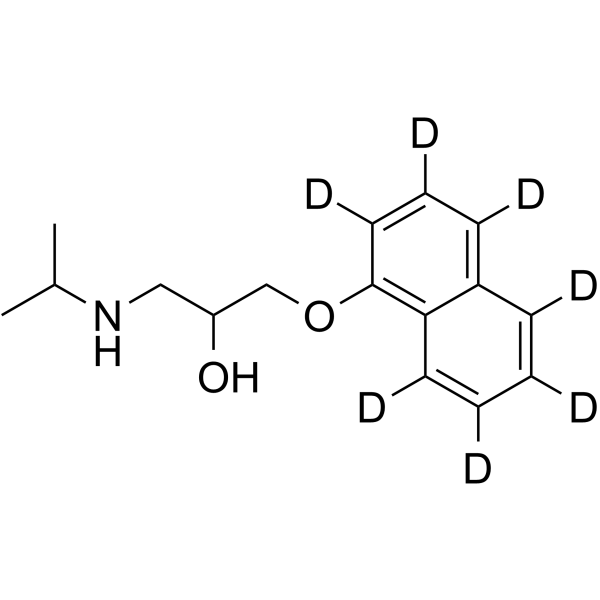
-
-
HY-L118
-
|
|
128 compounds
|
|
Sodium channels conduct sodium ions (Na+) through a cell's plasma membrane that are the source of excitatory currents for the nervous system and muscle. Na channels are classified according to the trigger that opens the channel for such ions, i.e. either a voltage-change (Voltage-gated, voltage-sensitive, or voltage-dependent sodium channel also called VGSCs or Nav channel) or a binding of a substance (a ligand) to the channel (ligand-gated sodium channels). Dysfunction in voltage-gated sodium channels correlates with neurological and cardiac diseases, including epilepsy, myopathies, pain and cardiac arrhythmias. Sodium channel blockers are used in the treatment of cardiac arrhythmia, pain and convulsion.
MCE offers a unique collection of 128 sodium channel blocker and antagonists, all of which have the identified inhibitory effect on sodium channels. MCE Sodium Channel Blocker Library can be used for neurological and cardiac diseases drug discovery and sodium channel research.
|
| Cat. No. |
Product Name |
Type |
-
- HY-107754
-
|
|
Biochemical Assay Reagents
|
|
Cesium chloride is a blocker of potassium channel. Cesium chloride prevents the decrease of Na + transport produced by Alloxan . Cesium chloride has induced cardiac arrhythmias, including torsade de pointes in animal models .
|
| Cat. No. |
Product Name |
Category |
Target |
Chemical Structure |
| Cat. No. |
Product Name |
Chemical Structure |
-
- HY-17497S
-
|
|
|
Acebutolol-d7 is a deuterium labeled Acebutolol. Acebutolol is a selective β1 adrenergic receptor antagonist used in the treatment of hypertension, angina pectoris and cardiac arrhythmias[1].
|
-

-
- HY-A0084S
-
|
|
|
Procainamide-d4 hydrochloride is deuterated labeled Procainamide. Procainamide hydrochloride is an antiarrhythmic agent used in the study of cardiac arrhythmias.
|
-

-
- HY-A0084S1
-
|
|
|
Procainamide- 13C2 hydrochloride is 13C labeled Procainamide. Procainamide hydrochloride is an antiarrhythmic agent used in the study of cardiac arrhythmias.
|
-

-
- HY-119802S
-
|
|
|
Practolol-d7 is the deuterium labeled Practolol. Practolol is a potent and selective β1-adrenergic receptor antagonist. Practolol can be used for the research of cardiac arrhythmias[1][2][3].
|
-

-
- HY-B0632S
-
|
|
|
Diltiazem-d6 is the deuterium labeled Diltiazem. Diltiazem is an orally active L-type Ca2+ channel blocker, with antihypertensive and antiarrhythmic effects. Diltiazem can be used for the research of cardiac arrhythmia, hypertension, and angina pectoris[1][2][3].
|
-

-
- HY-17429S
-
|
|
|
Flecainide-d4 (acetate) is the deuterium labeled Flecainide acetate. Flecainide acetate (R-818) is a class 1C antiarrhythmic agent especially used for the management of supraventricular arrhythmia; works by blocking the Nav1.5 sodium channel in the heart, causing prolongation of the cardiac action potential[1][2].
|
-

-
- HY-B0573BS
-
|
|
|
Propranolol-d7 is the deuterium labeled Propranolol. Propranolol is a nonselective β-adrenergic receptor (βAR) antagonist, has high affinity for the β1AR and β2AR with Ki values of 1.8 nM and 0.8 nM, respectively[1]. Propranolol inhibits [3H]-DHA binding to rat brain membrane preparation with an IC50 of 12 nM[2]. Propranolol is used for the study of hypertension, pheochromocytoma, myocardial infarction, cardiac arrhythmias, angina pectoris, and hypertrophic cardiomyopathy[3].
|
-

-
- HY-B0573S1
-
|
|
|
Propranolol-d7 (ring-d7) is the deuterium labeled Propranolol hydrochloride. Propranolol hydrochloride is a nonselective β-adrenergic receptor (βAR) antagonist, has high affinity for the β1AR and β2AR with Ki values of 1.8 nM and 0.8 nM, respectively[1]. Propranolol hydrochloride inhibits [3H]-DHA binding to rat brain membrane preparation with an IC50 of 12 nM[2]. Propranolol hydrochloride is used for study of hypertension, pheochromocytoma, myocardial infarction, cardiac arrhythmias, angina pectoris, and hypertrophic cardiomyopathy[3].
|
-

Your information is safe with us. * Required Fields.
Inquiry Information
- Product Name:
- Cat. No.:
- Quantity:
- MCE Japan Authorized Agent:













































